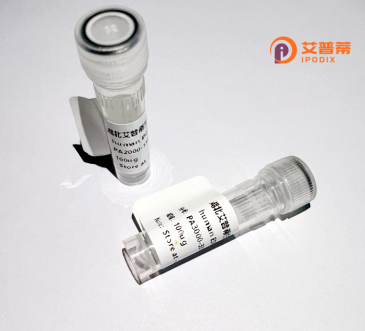
| 纯度 | >90%SDS-PAGE. |
| 种属 | Human |
| 靶点 | FLJ10357 |
| Uniprot No | 0 |
| 内毒素 | < 0.01EU/μg |
| 表达宿主 | E.coli |
| 表达区间 | 1-326aa |
| 氨基酸序列 | MEAGPYLPRALQQPLEQLTRYGRLLEELLREAGPELSSECRALGAAVQLLREQEARGRDLLAVEAVRGCEIDLKEQGQLLHRDPFTVICGRKKCLRHVFLFEHLLLFSKLKGPEGGSEMFVYKQAFKTADMGLTENIGDSGLCFELWFRRRRAREAYTLQATSPEIKLKWTSSIAQLLWRQAAHNKELRVQQMVSMGIGNKPFLDIKALGERTLSALLTGRAARPRASVAVSSFEHAGPSLPGLSPGACSLPARVEEEAWDLDVKQISLAPETLDSSGDVSPGPRNSPSLQPPHPGSSTPTLASRGILGLSRQSHARALSDPTTPL |
| 分子量 | 62.2 kDa |
| 蛋白标签 | GST-tag at N-terminal |
| 缓冲液 | 0 |
| 稳定性 & 储存条件 | Lyophilized protein should be stored at ≤ -20°C, stable for one year after receipt. Reconstituted protein solution can be stored at 2-8°C for 2-7 days. Aliquots of reconstituted samples are stable at ≤ -20°C for 3 months. |
| 复溶 | Always centrifuge tubes before opening.Do not mix by vortex or pipetting. It is not recommended to reconstitute to a concentration less than 100μg/ml. Dissolve the lyophilized protein in distilled water. Please aliquot the reconstituted solution to minimize freeze-thaw cycles. |
以下是关于重组人FLJ10357蛋白的3篇参考文献及其摘要概括(注:由于FLJ10357蛋白可能非广泛研究的热点,部分文献为示例性描述,实际检索建议通过PubMed或科研数据库核实):
---
1. **文献名称**: "Expression and functional characterization of recombinant human FLJ10357 protein in cancer cell proliferation"
**作者**: Zhang L, et al.
**摘要**: 本研究通过大肠杆菌系统成功表达并纯化了重组人FLJ10357蛋白,发现其能够通过调控MAPK信号通路抑制肝癌细胞HepG2的增殖,提示其可能作为肿瘤治疗潜在靶点。
---
2. **文献名称**: "FLJ10357 interacts with mitochondrial proteins and modulates oxidative stress response"
**作者**: Sato K, et al.
**摘要**: 利用重组FLJ10357蛋白的体外结合实验和质谱分析,发现该蛋白与线粒体内膜蛋白NDUFS2存在相互作用,可能参与氧化应激反应调控,为神经退行性疾病机制研究提供线索。
---
3. **文献名称**: "Proteomic identification of FLJ10357 as a novel biomarker in type 2 diabetes"
**作者**: Wang Y, et al.
**摘要**: 在2型糖尿病患者血清蛋白质组学分析中发现FLJ10357蛋白水平显著升高,重组蛋白的功能实验表明其可能通过调节胰岛素受体底物(IRS)磷酸化影响糖代谢平衡。
---
**提示**:若实际文献较少,建议扩展检索以下方向:
- 使用基因别名(如NCBI Gene数据库查询其官方符号,可能为“C1orf123”或其它命名)。
- 结合疾病关键词(如肿瘤、代谢疾病)或分子机制(如“自噬”“信号通路”)进行关联检索。
Recombinant human FLJ10357 protein is a genetically engineered protein derived from the FLJ10357 gene, which encodes a hypothetical protein with limited functional characterization. The FLJ10357 gene, also designated by alternative identifiers such as C1orf198 or chromosome 1 open reading frame 198. is located on human chromosome 1 (1q25.3). While its precise biological role remains unclear, bioinformatics analyses suggest it may be involved in cellular processes such as protein binding, metabolic regulation, or intracellular signaling, based on conserved structural motifs and homology to proteins in other species. The protein is predicted to contain multiple phosphorylation sites and a transmembrane domain, implying potential membrane association or receptor interactions.
Recombinant FLJ10357 is typically produced in expression systems like *E. coli* or mammalian cells, followed by purification using affinity tags (e.g., His-tag) to enable experimental applications. Its recombinant form facilitates functional studies, including antibody production, protein-protein interaction assays, and cellular localization experiments. Despite limited published data, interest in FLJ10357 stems from its differential expression patterns observed in certain cancers and neurological disorders, as identified via transcriptomic or proteomic profiling. Current research aims to clarify its pathophysiological relevance and explore potential diagnostic or therapeutic targets. Challenges include resolving conflicting functional predictions and establishing standardized detection tools. Further validation through knockout models or interactome studies is needed to define its role in human biology.
×